Products You May Like
Get access to everything we publish when you
sign up for Outside+.
With the new year just around the corner, we’ve had the chance to preview some of the models running shoe brands are rolling out in 2023. Based on the sneak peeks at The Running Event, the coming year promises to bring a pack of smooth-rolling shoes that combine the latest materials and designs to deliver versatile, comfortable, and speedy rides for every runner’s needs and preferences.
Here are a few models that we’re most excited about training and racing in so far.
Hoka Rocket X 2 ($275)

Fast and Flash
Hoka’s long-awaited Rocket X 2 is almost ready for launch. After being on the feet of its elite athletes in the Boston Marathon, Ironman World Championship, Chicago Marathon and New York City Marathon, it will finally become available to consumers on March 1. The Rocket X 2 has a new formulation of Hoka’s super-critical midsole foam and 40mm in the heel, 35mm in the forefoot.
Launches March.
Saucony Kinvara Pro ($180)

Speed For the Rest of Us
This new entry to the very popular-for-triathletes Kinvara line is considered “carbon for the regular runner” with a dual-density midsole sporting two flavors: Saucony’s PWR RUN plate below and PWR RUN PB above. This carbon setup is tuned for higher-mileage weeks, basically a tear drop-shaped carbon shoe that could be used outside of racing. Think: a racer for “slower” runners—(i.e., not pros) 8:30 pace runners who do not necessarily get the full benefit from carbon race shoes because they are not running the faster paces.
Kinvara Pro will be available in summer 2023.
Speedland GS:TAM ($275)
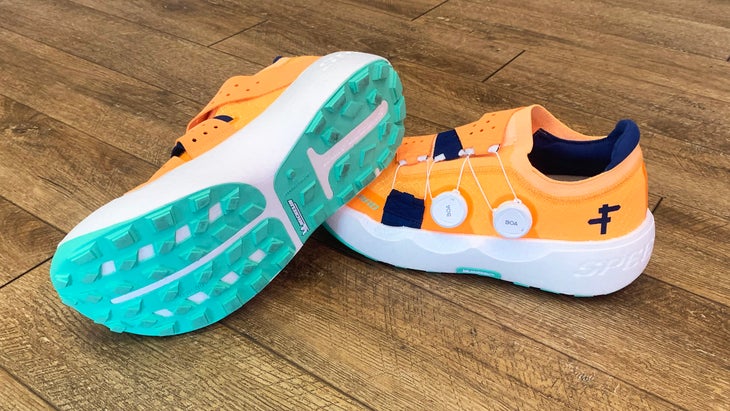
Foot-Coddler Supreme
The first Speedlands rewrote the rules on using high-end materials and components in a shoe, with a $375 price tag to prove it. But the ride was so exceptional that the brand sold out of the initial limited run and only has a few sizes left of their second, similar model. So, while they plan to make more of the new GS:TAM version, you’d better act quickly if you want a pair, especially as they’ve dropped the price a hundred dollars while upgrading the cushioning and keeping most of the features.
As in the original model, the upper’s two, two-way BOA dials make it super easy to lock down a perfect fit (although the dials are now plastic instead of Anodized aluminum). And the shoe retains the unsurpassed underfoot sensation of stepping directly onto a thick slab of a soft, bouncy PEBAX-based foam with no insole in the way. However, the Carbitex plate beneath that removable top layer is now optional and will cost you another $35 for the additional stability and snap it provides. The overall stack height also went up four millimeters in the heel and two millimeters in the forefoot (to 37-30mm), yet the weight remained essentially the same. On a quick preview run at The Running Event in early December, I found the ride comfortable, smooth, and connected, without the close-to-the-ground edge of the first Speedland, but not at all top-heavy or squishy. I didn’t want to give them back after my few strides in them and can’t wait to put long miles on a pair.
Launches in March
Reebok FloatZig 1 ($130)
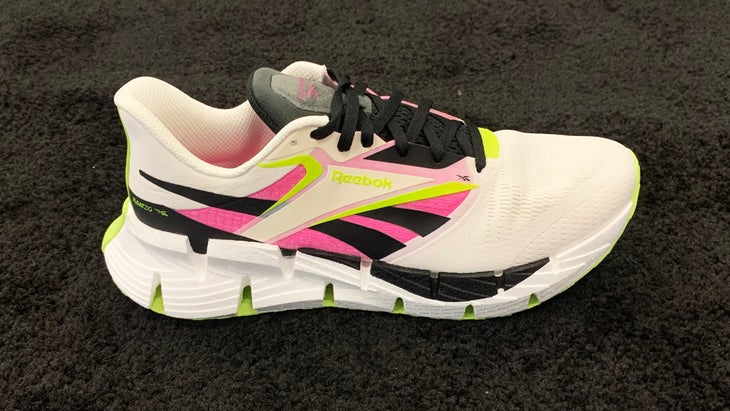
Retro Retooled
Remember Reebok Zigtech? Maybe not. It came out in 2010 amid a flurry of running shoe innovation and might have been ahead of its time—but was largely dismissed as a gimmick. This year, Reebok has decided the sport is ready to embrace the tech that has been languishing in the lifestyle channel for a decade. The first shoe in “The New Shape of Running” collection will be the FloatZig 1.
The key to the FloatZig’s up-to-date performance comes from combining the zigzag midsole geometry with high-performance foam. “There are benefits to using that shape,” says Keith Stern, senior product manager. “You get mechanical cushioning—compression and compliance—from the shape, and energy return and cushioning from the base foam material.” Indeed, Stern says that in lab tests the FloatZig delivered better cushioning and energy return than their plated FloatRide Energy X model.
I recall that the original Zigtech shoes delivered a surprisingly smooth, peppy ride, and I anticipate that responsiveness will be enhanced by the superior bounciness of Reebok’s top-of-the-line, TPE-based Floatride Energy foam. With a moderate height and drop (31mm heel, 25mm forefoot), light weight (9.4 ounces all gender), and bargain price ($130), this looks like an accessible trainer for young runners that can also hold its own against high-performance, high-mileage models.
Launches in October
Topo Cyclone 2 ($150)
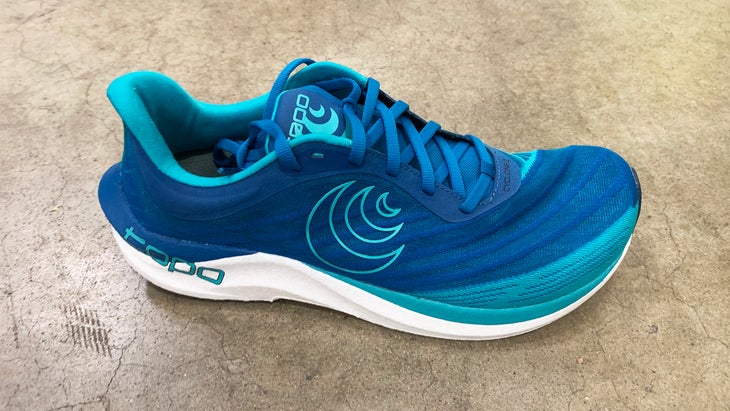
Supershoe Minimized
Topo’s shoes combine minimalist design principles—low drop, roomy forefoot—with modern foams and geometries to create natural rides that are accessible to all. While they’ve built some rugged trail shoes and higher-stack, high-mileage trainers, the best Topos, in my opinion, have been light, responsive, simple, and unobtrusive. The lightweight Cyclone 2 promises to take those characteristics to a new level.
The original Cyclone, with a bouncy zip-foam core inside a firmer EVA frame, was an improvement on the Zephyr, which had a flexible plate that sometimes got in the way. The new Cyclone takes the franchise one step simpler with a full midsole of ultra-soft, hyper-rebounding Pebax superfoam. The wide stance and low stack heights (28mm heel, 23mm forefoot) let the shoe get away without needing a plate for stability and keep it ultralight (6.9 ounces men’s, 5.5 ounces women’s). I’m expecting a shoe that disappears on your foot while delivering a nimble, bouncy ride with exquisite ground feel.
Launches in February
Puma Foreverrun Nitro ($150)

Smooth, Sexy Stability
Puma’s return to taking running seriously has produced a gym-bag full of flashy, bouncy, nitrogen-infused speedsters for training and racing. Now they’ve turned that design eye onto a shoe designed for guidance, although you couldn’t tell that by their looks, sub-10 ounce weight, or plush, smooth-rolling ride. Stability may never have been this sexy before, nor as subtle.
Beneath the splashy upper is a dual-density nitrogen-infused midsole with a wide, firm frame surrounding a softer inner core. A semi-rigid plastic external heel wrap adds some stability, but nothing runs under the foot or tries to alter its natural path—the frame and the geometry simply keep the foot centered and supported over the moderately-high platform (36mm heel, 26mm forefoot). As a fan of both Puma’s Nitro foam and of shoes with wide-based frames (like the Saucony Tempus and Topo Specter), I’m excited to try out the Foreverrun’s ride, which promises to be comfortable and comforting on long days, recovery days, and any day I just want my shoe to hold me up a bit.
Launches in March
Brooks Catamount 2 ($170)
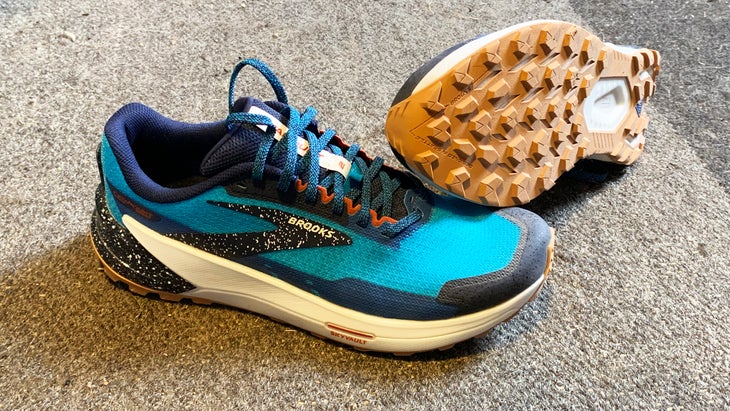
Agile Versatility
I’m anxious to run in the new Catamount, mostly so I can try out its unique propulsion plate. Brooks calls it the “Sky Vault” and promises it will help me fly over hills as well as roll smoothly over a variety of terrains. It’s shaped like some kind of sea creature, with two tentacles extending to the back and three reaching out front, and is made of flexible, rebounding Pebax, a material often used for track spike plates. This magic plate, according to product line manager Nick Colton, “allows you to be more agile and precise on trails, able to jump over rocks and boulders, and have more propulsion and efficiency uphill.” I want some of that.
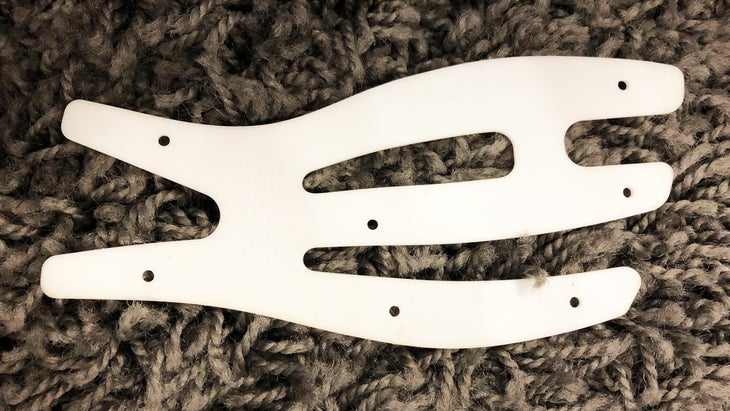
This plate is embedded into a slab of Brooks’ bouncy, nitrogen-infused DNA Flash midsole foam, which, Colton says, is tuned to be softer and more flexible than in the original version (which I found quite stiff). The softer ride should deliver both more cushioning for long miles and more adaptability over rocks and rough terrain. It still looks low and resilient enough, however, to provide a stable ground feel and a fast, nimble ride. I imagine it will, like its predecessor, excel at any distance and over most any terrain, from road to technical single-track.
Launches in February
Skechers GoRun Speed Beast ($200–250)
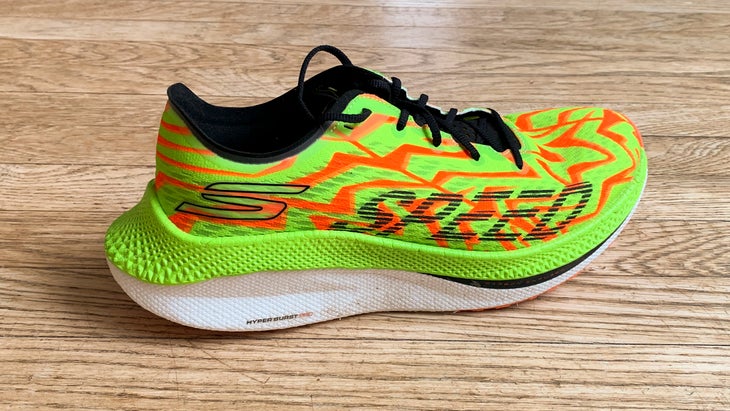
Max-Height Speedster for the Rest of Us
While Skechers has created several plated models over the years, they’ve yet to produce a high-stack, max-cushion marathon-racing supershoe. Their original carbon-infused plated shoe, the Speed Elite, was only 23 millimeters thick in the heel and had a firm ride more like a traditional racing flat. The Speed Freak added more cushioning, but still topped out at only 34mm. Enter the Speed Beast, which pushes the height to the legal max (40mm heel, 36mm forefoot) and incorporates Skechers’ new, softer, lighter and more responsive Hyper Burst Pro foam.
I’m excited about running in this shoe, however, not just because of the thick stack of TPU-based foam (that I love in the Razor 4), but also because the Speed Beast promises to be supportive as well as fast. “It’s not built for the tip-of-the-spear marathoner,” says Keith Shelton, Skechers’ senior director of product development. “It’s really for the A, B corral runner.” To this end, the base is wider than other comparable racers, there’s more rubber on the bottom, and the top of the midsole is molded in a supportive foot cradle. Add this to Skecher’s winglet plate that increases lateral stability as well as speeds toe-off, plus their signature rockered and radiused heel shape that smooths landings, and it sounds like a shoe in which I could put in a lot of happy training and racing miles.
Launches in March
New Balance FuelCell SuperComp Trail
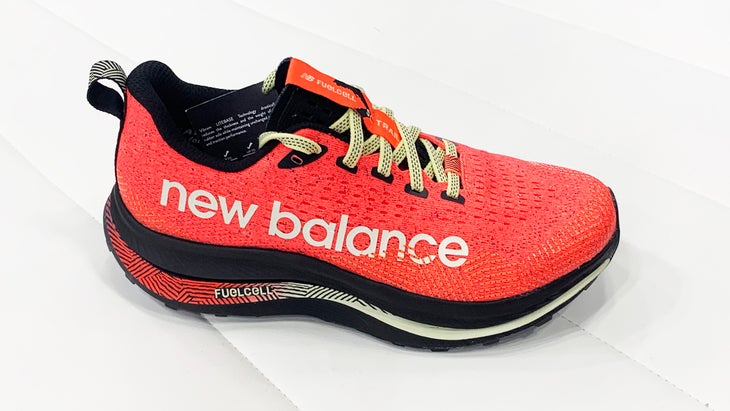
Techy Trail Dancer
New Balance’s SuperComp line, which combines curved carbon plates with high-rebound foams and unique midsole geometry, already has a speedy, low, fast road racer, an elite marathon supershoe, and an ultra-cushioned, trampoline-like trainer. Come summer it will also include a light (9.5 ounces men’s, 7.5 ounces women’s), low (31mm heel, 21mm forefoot) trail runner. Several brands have successfully integrated carbon plates into their trail lines—and some have tried and been not quite as successful. I’m looking forward to seeing how well the designers adapted New Balance’s tech to handle iffy terrain.
First off, says Paul Zelinski, senior product line manager, the foam beneath the plate is firmer, “so they don’t feel super squirrelly—you’re not mushing or flattening out.” Above the plate, high-energy rebound FuelCell foam provides soft touchdowns and explosive push-offs. The plate itself is split in the forefoot to allow horizontal flexibility, but the prong under the medial side is wider to provide snap during big toe propulsion. None of these specific strategies are completely new, but given the smooth ride of other FuelCell models, I’m betting New Balance has combined them into a unique shoe that dances over the trail.
Launches in August or September
